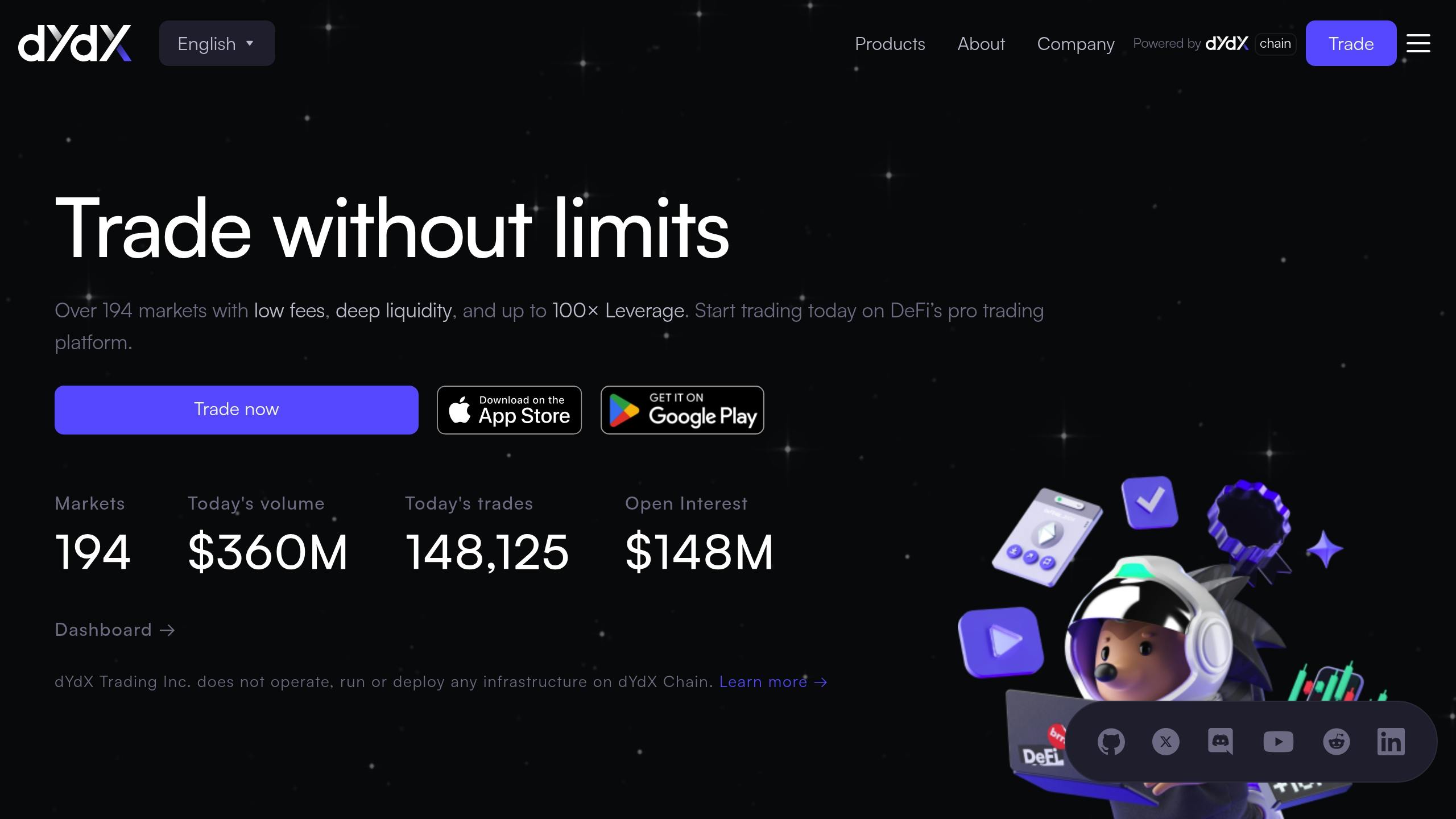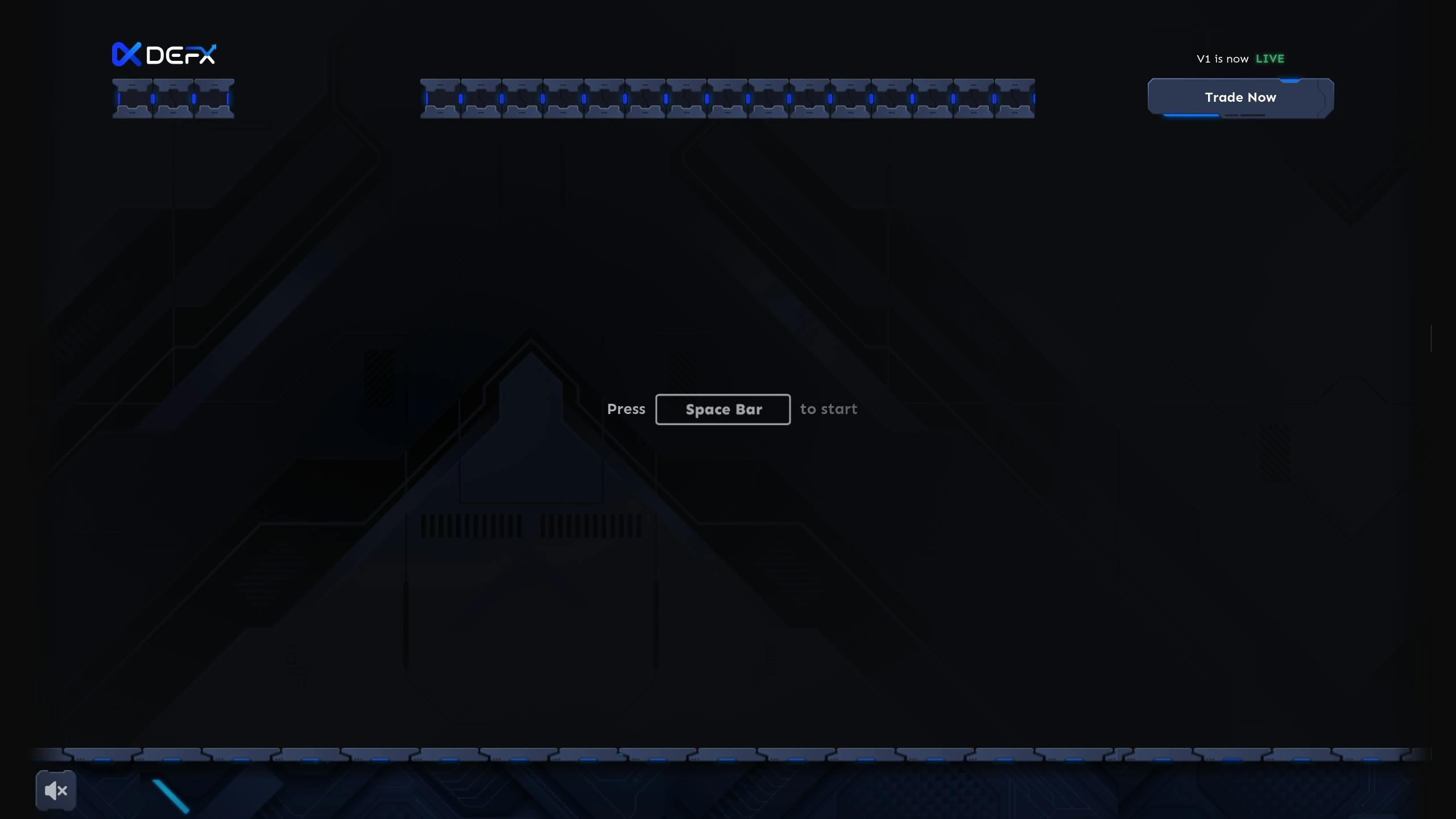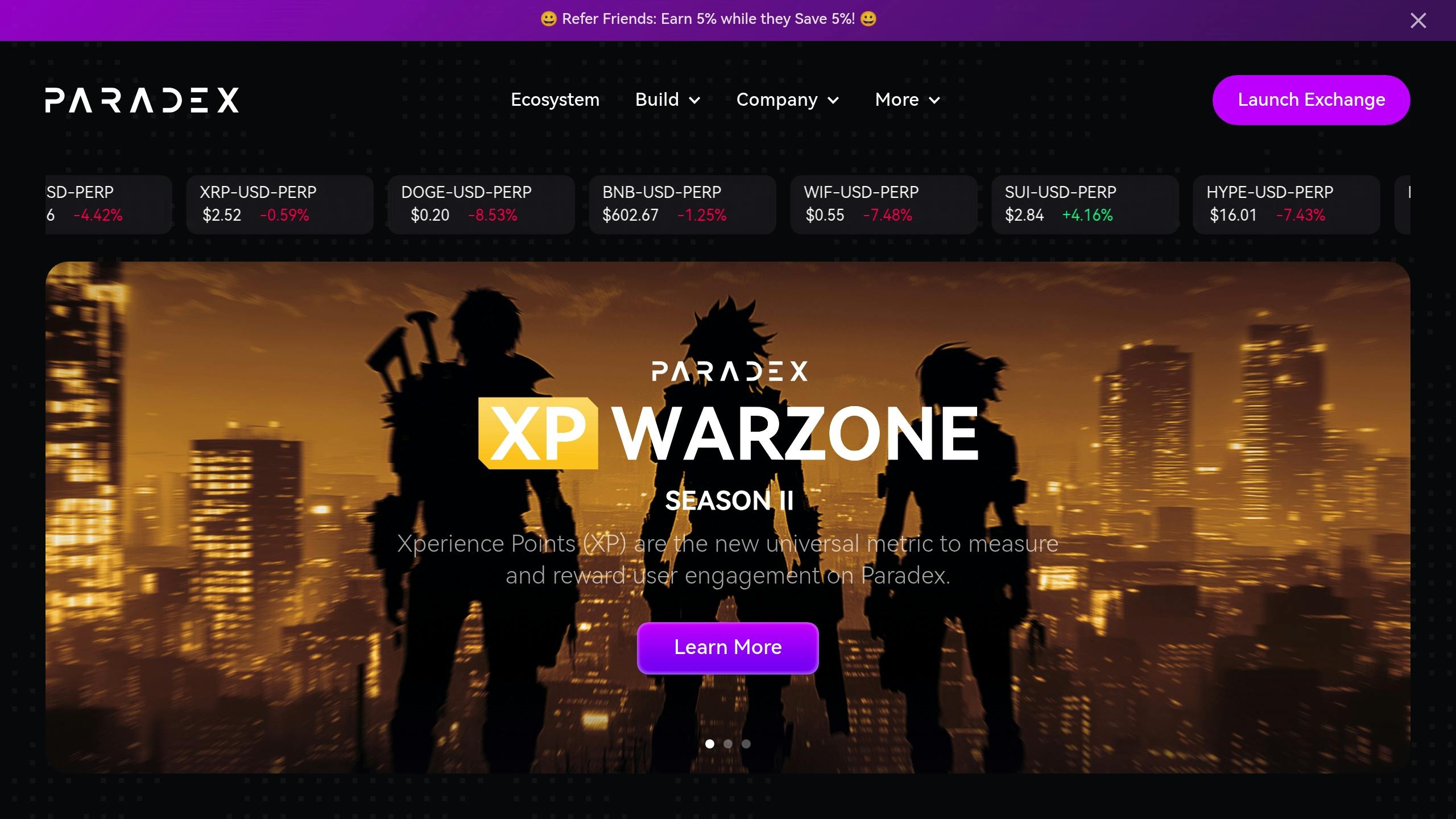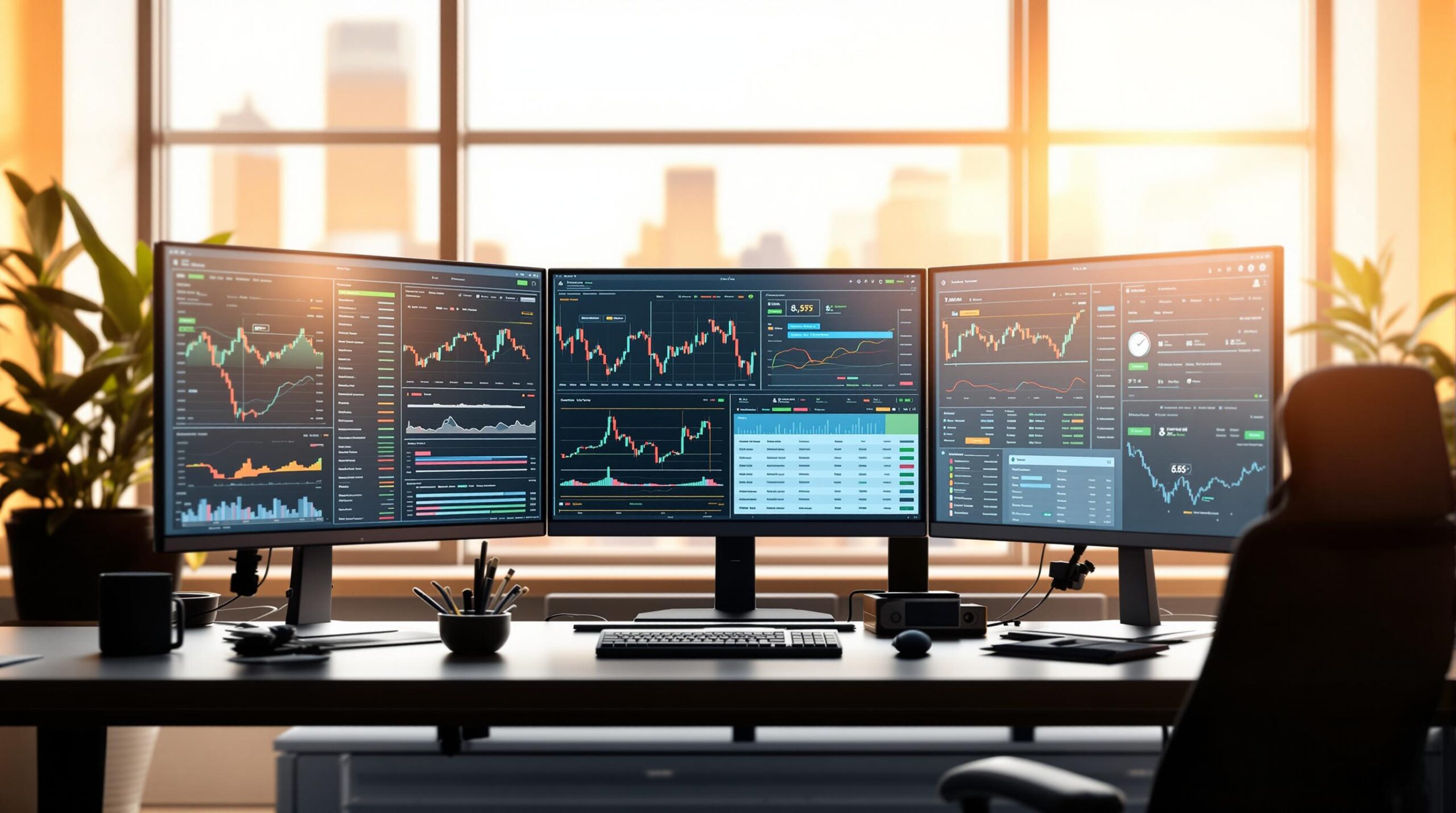Looking for alternatives to HyperLiquid for decentralized perpetual trading? Here’s a quick rundown of four top platforms: dYdX, Vertex, Defx, and Paradex. Each offers unique features tailored to different trading needs, from high leverage to memecoin trading and cross-chain compatibility.
Key Insights:
- dYdX: Up to 25× leverage, 35+ crypto pairs, low fees (0.01%-0.05%), built on its custom Cosmos-based chain.
- Vertex: Combines spot, perpetual, and money markets on Arbitrum, with 5–15ms order execution and competitive fees (0% maker, 0.02% taker).
- Defx: Focuses on memecoin margin trading (up to 50× leverage) across Solana and EVM networks with permissionless token listing.
- Paradex: Built on Starknet’s Appchain, offers sub-50ms latency, gasless execution, and a simple fee structure (maker rebate: -0.005%, taker fee: 0.03%).
Quick Comparison:
| Platform | Leverage | Latency | Margin Types | Key Features | Maker Fee | Taker Fee |
|---|---|---|---|---|---|---|
| dYdX | Up to 25× | Sub-1 second | Perpetual contracts | 35+ crypto pairs, low fees | 0.02%-0% | 0.05%-0.2% |
| Vertex | Up to 10× | 5–15ms | Unified & isolated | Spot, perpetuals, high-frequency API | 0% | 0.02% |
| Defx | Up to 50× | Sub-second | Cross & isolated | Memecoin trading, permissionless listing | Competitive | Competitive |
| Paradex | Planned updates | Sub-50ms | Planned portfolio margin | Gasless execution, Starknet Appchain | -0.005% | 0.03% |
Which is right for you? If you need high leverage and diverse markets, go for dYdX. Want speed and multi-functional trading? Vertex is a solid choice. Memecoin enthusiasts should explore Defx. For low fees and Starknet-based performance, Paradex shines. Dive into the article for detailed platform insights.
Best Decentralized Crypto Leverage Trading Exchange – dYdX vs. Apex Pro Comparison

1. dYdX Exchange
dYdX is a leader in decentralized derivatives trading, boasting over $1 trillion in lifetime trading volume as of December 2023. Built on its custom dYdX Chain using the Cosmos SDK, the platform offers lightning-fast performance with sub-1-second latency and processes more than $1 billion in daily trading volume.
What Sets dYdX Apart?
- Offers leverage trading up to 25×.
- Provides perpetual contracts for top cryptocurrencies like BTC, ETH, SOL, and DOGE.
- Supports advanced order types, including stop-loss and limit orders.
- Features a cross-margined trading system for efficient capital use.
The platform’s fees are highly competitive, ranging from 0.01% to 0.05% depending on trading volume. Traders handling less than $100,000 monthly enjoy zero fees.
dYdX uses a hybrid architecture combining centralized and decentralized elements, powered by StarkWare‘s StarkEx scalability engine. Since launching the dYdX Chain in October 2023, the platform has facilitated $232 billion in trading volume and distributed $39 million in USDC to validators and stakers. However, U.S. traders should note that the platform is not accessible in their region.
With its order book model, dYdX ensures precise price execution, making it an excellent choice for seasoned derivatives traders.
Up next, let’s dive into Vertex Protocol.
2. Vertex Protocol

Vertex Protocol brings together spot, perpetual, and money market trading, all on the Arbitrum network. Since its launch, the platform has processed an impressive $5.6 billion in trading volume and attracted 4,700 unique traders.
Using a hybrid model, Vertex combines a Central Limit Order Book (CLOB) with an Automated Market Maker (AMM). This setup allows trades to execute in just 5–15 milliseconds while handling up to 15,000 transactions per second – all without compromising decentralized security.
Trading Features
Vertex offers a variety of tools and options for traders, including:
- Cross-margin trading across all positions
- Isolated margin for better risk control
- Leverage trading up to 10×
- Access to over 50 markets
- High-frequency trading (HFT) API support
Fee Structure
Vertex keeps trading costs low with the following fees:
| Fee Type | Rate |
|---|---|
| Maker Fee | 0% |
| Taker Fee (Core Markets) | 0.02% |
| Taker Fee (Spot) | 0.03% |
Performance Snapshot
On November 28, 2023, Vertex hit $1.63 billion in daily trading volume and reported a Total Value Locked (TVL) of $9.2 million.
Vertex Edge Technology
Vertex Edge enhances liquidity for perpetual markets by syncing across eight different chains through a single order book. This approach minimizes fragmentation and ensures direct base-layer settlement. Additionally, the platform’s Trade & Earn program incentivizes users with VRTX tokens and staking benefits.
These capabilities make Vertex a strong contender among decentralized platforms.
sbb-itb-dd9e24a
3. Defx Trading Platform

Defx builds on the speed and liquidity features seen in Vertex but shifts its focus to memecoin trading and multi-chain functionality.
The platform specializes in memecoin margin trading on Solana and EVM networks, offering high leverage and permissionless token listings for early access to emerging markets.
Multi-Chain Architecture
Defx operates across both Solana and EVM networks, delivering key benefits:
- Fast transactions and low fees on Solana
- EVM compatibility, enabling smooth integration with Ethereum-based tools
- Cross-chain liquidity, enhancing trading opportunities
- High leverage trading, with up to 50x options
This dual-network setup powers the platform’s trading features and flexibility.
Trading Features That Stand Out
| Feature | What It Offers |
|---|---|
| Pre-launch Markets | Trade tokens before they officially list |
| Permissionless Listing | List new tokens without restrictions |
| Dual Margin Options | Choose between Isolated or Cross margin |
| Non-custodial Trading | Retain full control over your funds |
Advanced Trading Infrastructure
Defx is equipped with a highly capable trading system, which includes:
- A fast and efficient order-matching engine
- Integration with existing decentralized exchange (DEX) liquidity pools
- Decentralized money market capabilities
- Improved capital management through cross-margin trading
Why Memecoin Traders Should Care
Defx skips perpetual contracts to focus on direct memecoin margin trading. This approach allows traders to access tokens early, manage risks more flexibly, and benefit from lower entry barriers. By aggregating liquidity from decentralized exchanges and integrating with Jupiter‘s routing system, the platform ensures better trade execution and access to deep liquidity pools.
4. Paradex Exchange

Paradex is a decentralized perpetual futures exchange built on Starknet’s first Appchain. It combines the speed of centralized exchanges with the transparency of decentralized finance.
Performance and Architecture
Paradex operates on a hybrid architecture that delivers sub-50ms latency, gasless execution, and zero-knowledge proof consensus. It also integrates both off-chain and on-chain processing to enhance efficiency.
Trading Features and Fees
Paradex offers a simple and competitive fee structure designed to appeal to both market makers and takers:
| Trading Role | Fee Structure |
|---|---|
| Maker Rebate | -0.005% |
| Taker Fee | 0.03% |
| Volume Requirements | None |
This straightforward approach stands out, especially for traders handling less than $25 million in bi-weekly volume, compared to HyperLiquid’s more complex fee model.
Market Performance Metrics
Paradex’s performance is reflected in these key metrics:
- Total Value Locked (TVL): $37.97 million
- Cumulative Trading Volume: $48.115 billion
- 24-Hour Perpetual Trading Volume: $112.03 million
Key Features and Developments
"As we began evaluating blockchain scaling technologies that would enable Paradex’s ambitious vision, it became clear that we needed a solution that would not only deliver performance and scalability, but also control and customization. A private instance of Starknet, or Appchain, provides this in abundance."
Some notable aspects of Paradex include:
- Portfolio Margin planned for January 2025
- Cross Margin support for Perpetual Options
- 57.6% of the total $DIME supply allocated to the community
- A planned internal spot oracle system
Current Challenges
Paradex faces a few limitations as it continues to grow:
- TVL remains lower than major competitors
- Still in Stage 0 Rollup development
- Isolated margin trading is not yet available
Despite these challenges, Paradex is steadily carving out its place as a strong contender in the decentralized derivatives trading space.
Platform Comparison
Decentralized trading platforms are evolving rapidly, and for leveraged traders, it’s important to evaluate both their technical capabilities and market access. Here’s a breakdown of how these HyperLiquid alternatives stack up in key areas.
Trading Features and Performance
| Feature | dYdX | Vertex | Defx |
|---|---|---|---|
| Leverage | Up to 25× | Unified cross & isolated | Up to 50× |
| Latency | Layer-2 optimized | 5–15 ms | Sub-second |
| Margin Types | Perpetual contracts | Unified cross & isolated | Cross & isolated |
| Asset Coverage | 35+ pairs | Spot & perpetuals | Permissionless listing |
Fee Structures
| Platform | Maker Fee | Taker Fee | Notable Features |
|---|---|---|---|
| dYdX | 0.02% to 0% | 0.05% to 0.2% | Volume-based tiers |
| Vertex | 0% | 0.02% | Competitive pricing |
| Defx | Competitive | Competitive | Free token listing |
Fee structures are just one part of the story. Each platform’s underlying technology plays a major role in shaping the trading experience. dYdX uses StarkWare’s STARK rollups on Ethereum for enhanced scalability. Vertex blends centralized exchange-level performance with decentralized settlement, offering a hybrid solution. Meanwhile, Defx operates on both Solana and Ethereum, catering to niche markets like memecoin margin trading.
When it comes to assets and market access, these platforms cater to different needs. dYdX focuses on over 35 curated derivative pairs, prioritizing well-established cryptocurrencies. Vertex provides a robust ecosystem with spot markets, perpetual contracts, and embedded money markets. Defx sets itself apart by offering early access to emerging tokens and pre-launch markets.
Capital Efficiency
Capital usage is a key consideration for traders. Vertex simplifies this with a unified margin account that consolidates balances and positions. Similarly, Defx supports both isolated and cross-margin trading, giving users more flexibility to manage risk.
Market Impact
dYdX has seen broad market adoption, reflecting the increasing demand for advanced decentralized trading platforms. Its growing user base highlights its position as a leader in this space.
Final Assessment
Each alternative to HyperLiquid brings its own strengths to the table. Defx shines with its built-in cross-chain support for Solana and EVM, a focus on memecoin margin trading, and a permissionless listing system that grants early access to new tokens.
While dYdX is known for its mature trading infrastructure and Vertex employs a synchronous orderbook model for cross-chain liquidity, Defx offers distinct advantages that set it apart in this competitive space:
| Feature | Benefit | Outcome |
|---|---|---|
| Leverage Options | Up to 1,000× leverage | Greater trading flexibility |
| Cross-chain Support | Seamless Solana & EVM integration | Access to a wider range of markets |
| Token Listing | Permissionless system | Early exposure to new opportunities |
| Margin Trading | Supports isolated and cross-margin | Better risk management for traders |
These features highlight Defx’s ability to meet diverse trading needs while expanding market access. Its offerings align with the growing expectations of traders, showcasing its forward-thinking approach in decentralized trading.
Additionally, Defx’s high-speed engine ensures quick trade execution, and its non-custodial design prioritizes both security and transparency. This robust combination of features makes Defx a strong contender for traders looking for advanced tools across multiple blockchain networks.
